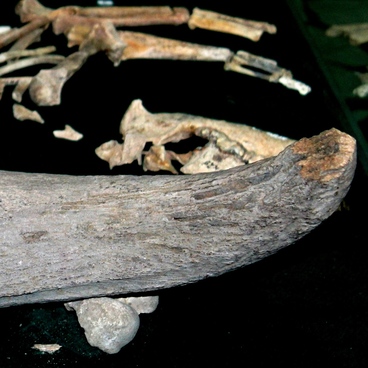The ladle from the collection of the Bryansk Local History Museum was made between 16th b 17th centuries. It was forged from red copper – this metal was easy to treat and did not rust over time. For the vessel to serve longer, it was tinned, i.e. thinly coated with melted tin. After this kind of treatment, copper did not oxidize and drinks, if long kept in the vessel, did not acquire a metal taste.
Copper ladle
Время создания
16th-17th centuries
Размер
7x20,5x11 cm
7х20.5х11 cm
7х20.5х11 cm
Техника
Red copper, forging, metalsmithing, tinning
Коллекция
Выставка
0
Открыть в приложении#1
Copper ladle
#2
#3
Such ladles were made by knocking out. A metalsmith first forged a half-round copper billet and then using special metalsmithing tools gave it the required shape.
#7
The ladle dimensions are relatively small: it is only 20 centimetres wide and 7 centimetres tall. A ladle like that was used to pour a drink from a big bowl with a spout, yendova, in which it was served on the table. For the drink not to miss the glass, the ladle had a sharp spout. The handle was hooked so that the vessel could be hung by the edge of the yendova.
The copper yendova. Source: ru.wikipedia.org
#5
The first ladles in Rus’ were wooden. They began to be made in ancient times. In different regions, they differed in shape and decoration. Northern princedoms would often have two-handled ladles. They were given the shape of the waterfowl – geese, ducks, and swans. In the Tver neighbourhood, they carved wooden vessels called “horses”. In its shape a ladle like that was like a round bowl with inward curving edges, and one of its edges was decorated with a carved horse’s head.
Ladles also differed in their purpose. Every occasion required a special vessel. For example, cellar ladles were not used to serve the table – they were used to keep drinks in or as measuring vessels. Grace ladles were used during feasts to pass around the table after toasting somebody’s health. Small drinking ladles were meant for one person and their volume was no more than a glass. The special-use tradition was not to be breached, and every family had ladles of different shapes and sizes decorated with painting, carving or metalsmithing. They were usually displayed in a pride of place.
#6
The 17th century saw the appearance of award ladles. They were awarded for different merits. Such vessels were forged from gold or silver, decorated with precious stones, carving, engraving and memorial inscriptions. They were kept as a family relic and were passed on from generation to generation. Should the holder of such an award fall in disgrace, the ladle was returned to the tsar’s treasury.
#8
Bryansk State Regional Ethnography Museum
читать дальшескрыть
00:00
00:00
1x
Copper ladle
Время создания
16th-17th centuries
Размер
7x20,5x11 cm
7х20.5х11 cm
7х20.5х11 cm
Техника
Red copper, forging, metalsmithing, tinning
Коллекция
Выставка
0
Открыть в приложении
Поделиться


